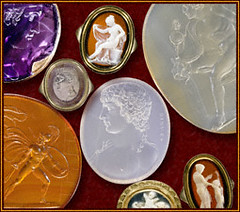
PREV ARTICLE
NEXT ARTICLE
FULL ISSUE
PREV FULL ISSUE
CARVERS AND COLLECTORS: EXHIBIT OF ANCIENT GEMS AT THE J. PAUL GETTY MUSEUMHarry Waterson writes: Here is a new exhibition at the Getty that may be of interest to your readers - Carvers and Collectors; The Lasting Allure of Ancient Gems.  The beauty of carved gemstones has captivated collectors, connoisseurs, and craftsmen since antiquity. Precious markers of culture and status, gems were sought by Greek and Roman elites as well as modern monarchs and aristocrats. The beauty of carved gemstones has captivated collectors, connoisseurs, and craftsmen since antiquity. Precious markers of culture and status, gems were sought by Greek and Roman elites as well as modern monarchs and aristocrats.This exhibition features intaglios and cameos carved by ancient master engravers along with outstanding works by modern carvers and works of art in diverse media that illustrate the lasting allure of gems. The exhibition includes gems by several ancient master carvers, including Epimenes, Solon, Dioskourides, and Gnaios. These carvers sometimes signed their works, but the majority of classical gems are unsigned. With careful examination, anonymous intaglios and cameos can be attributed to known masters based on characteristics they share with signed gems. In antiquity, gems were engraved with personal or official insignia that, when impressed on wax or clay, were used to sign or seal documents. Carved gems were valued not only for their distinctive designs, but also for the beauty of their stones, some of which were believed to have magical properties. From the Middle Ages to the 19th century, rulers, nobles, and wealthy merchants sought and traded classical gems, and carvers produced replicas and forgeries.  Sumptuous engraved catalogues of gem collections were published in the days before photography. Like the gems they illustrated, these volumes functioned as luxury objects. The engravings in these books sometimes improve upon the already excellent carving of the gems themselves. Sumptuous engraved catalogues of gem collections were published in the days before photography. Like the gems they illustrated, these volumes functioned as luxury objects. The engravings in these books sometimes improve upon the already excellent carving of the gems themselves.Louis Philippe d'Orléans (1725–1785), the great-grandson of King Louis XIV of France, published his gem collection in an elaborately engraved volume dedicated to his cousin King Louis XVI. The frontispiece, shown here, depicts the duke himself and also represents the superiority of gems over other art forms: in the foreground, two cupids inspect the contents of drawers pulled from a large gem cabinet, while symbols of architecture, sculpture, and painting are relegated to the upper right and lower left corners. For more information on the exhibit, see: Carvers and Collectors: The Lasting Allure of Ancient Gems (http://www.getty.edu/art/exhibitions/gems/index.html?cid=egetty090) I became introduced to engraved gems while visiting museums in London; they do have many parallels with numismatics. A number of engravers made gems as well as coin and medal dies, and many collectors acquired both gems and numismatic items. As noted above, there are many great books covering collections of gems, and perhaps therein will be found interesting information for the numismatic researcher. I would encourage E-Sylum readers living near Los Angeles to check out the Getty exhibit. Can anyone point us to a good recently-published reference on gems? -Editor Wayne Homren, Editor The Numismatic Bibliomania Society is a non-profit organization promoting numismatic literature. See our web site at coinbooks.org. To submit items for publication in The E-Sylum, write to the Editor at this address: whomren@gmail.com To subscribe go to: https://my.binhost.com/lists/listinfo/esylum All Rights Reserved. NBS Home Page Contact the NBS webmaster 
|